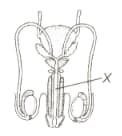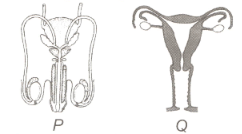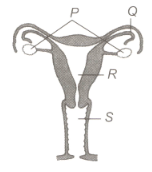Anil Ahlawat Solutions for Chapter: Reproduction and Endocrine System, Exercise 1: EXERCISES
Anil Ahlawat Science Solutions for Exercise - Anil Ahlawat Solutions for Chapter: Reproduction and Endocrine System, Exercise 1: EXERCISES
Attempt the practice questions on Chapter 9: Reproduction and Endocrine System, Exercise 1: EXERCISES with hints and solutions to strengthen your understanding. NSO Science Olympiad Workbook Grade 8 solutions are prepared by Experienced Embibe Experts.
Questions from Anil Ahlawat Solutions for Chapter: Reproduction and Endocrine System, Exercise 1: EXERCISES with Hints & Solutions
Which of the following is correct about the part labelled X?

Which of the following statements is incorrect regarding the female reproductive system?
Which of the following organisms undergo metamorphosis?
(i) Silk moth
(ii) Snake
(iii) Frog
(iv) Hen
(v) Butterfly
(vi) Human
(vii) Cat
(viii) Cockroach
(ix) Whale
(x) Dog
Read the given paragraph, where few words have been italicised.
The pineal gland secretes the hormone progesterone which helps to regulate sleep patterns. Thyroid glands release hormones that regulate the level of calcium in the blood with the help of calcitonin which is produced in the parathyroid glands.
Select the correct option regarding the given paragraph.
(i) Positions of pineal and parathyroid should be interchanged.
(ii) Progesterone should be replaced by melatonin.
(iii) Parathyroid should not be replaced as it is correctly mentioned.
(iv) Positions of progesterone and calcitonin should be interchanged.
(v) Positions of thyroid and parathyroid should be interchanged.
Match column I (Gland) with column II (Hormone secreted) and column III (Function/Action) and select the correct option from the codes given below.
| Column I | Column II | Column III | |||
| (a) | Pituitary | (i) | Adrenaline | (P) | It controls the activities of the other glands. |
| (b) | Thyroid | (ii) | Growth hormone | (Q) | It prepares the body to fight or run fast when needed. |
| (c) | Adrenal gland | (iii) | Thyroxine | (R) | It controls the female secondary sexual characteristics. |
| (d) | Pancreas |
(iv) |
Insulin | (S) | It regulates the metabolic rate and growth. |
| (e) | Ovary | (v) | Testosterone | (T) | It regulates sugar metabolism. |
| (f) | Testis | (vi) | Estrogen | (U) | It controls the male secondary sexual characteristics. |
Refer to the given figures, P and Q.

How do reproductive cells produced in P differ from those produced in Q in terms of production and their modes of storage?
Read the following statements and select the correct option.
(i) A daughter receives X-chromosome from her mother only.
(ii) Human beings possess 22 pairs of autosomes and 1 pair of sex chromosomes.
(iii) In mammals, embryo develops outside the mother's body.
(iv) A new human individual develops from a cell called gamete.
(v) Pituitary gland produces thyroid-stimulating hormone (TSH), which stimulates the thyroid to produce thyroxine.
(vi) A zygote is formed as a result of fertilisation.
Refer to the given figure. Identify the labelled parts (P-S) and select the correct option.

| P | Q | R | S | |
| A | Site of gamete production | Site of fertilization | Site of embryo development | Passage of sperm |
| B | Site of gamete production | Passage of sperm | Site of embryo development | Site of fertilization |
| C | Site of embryo development | Site of gamete production | Site of fertilization | Passage of sperm |
| D | Site of fertilization | Site of gamete production | Site of embryo development | Passage of sperm |
